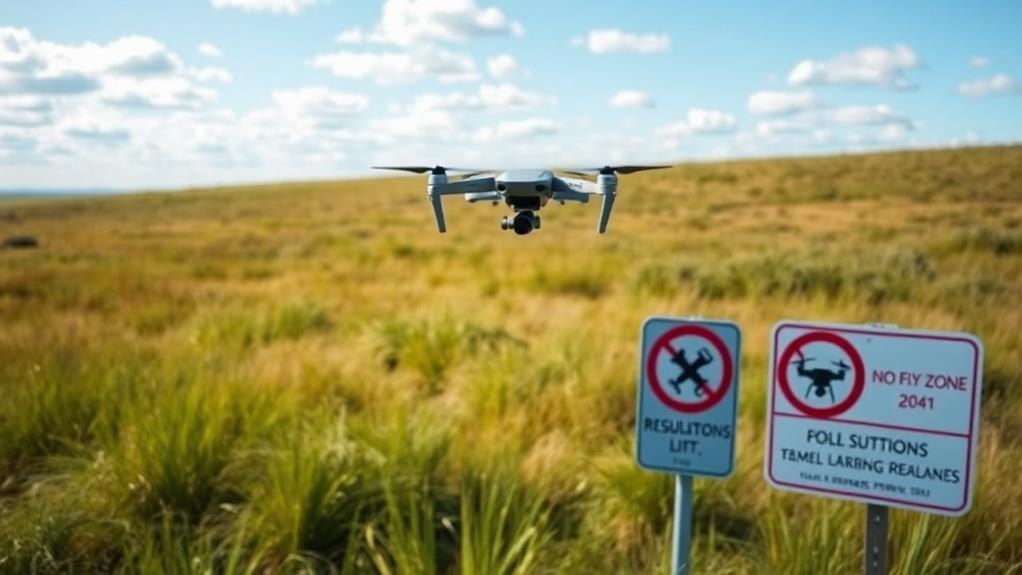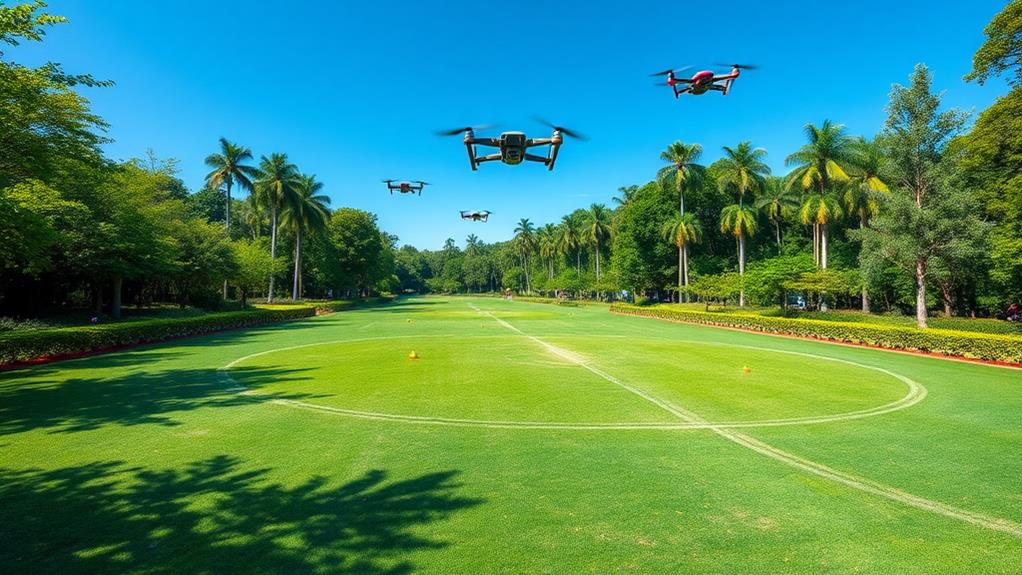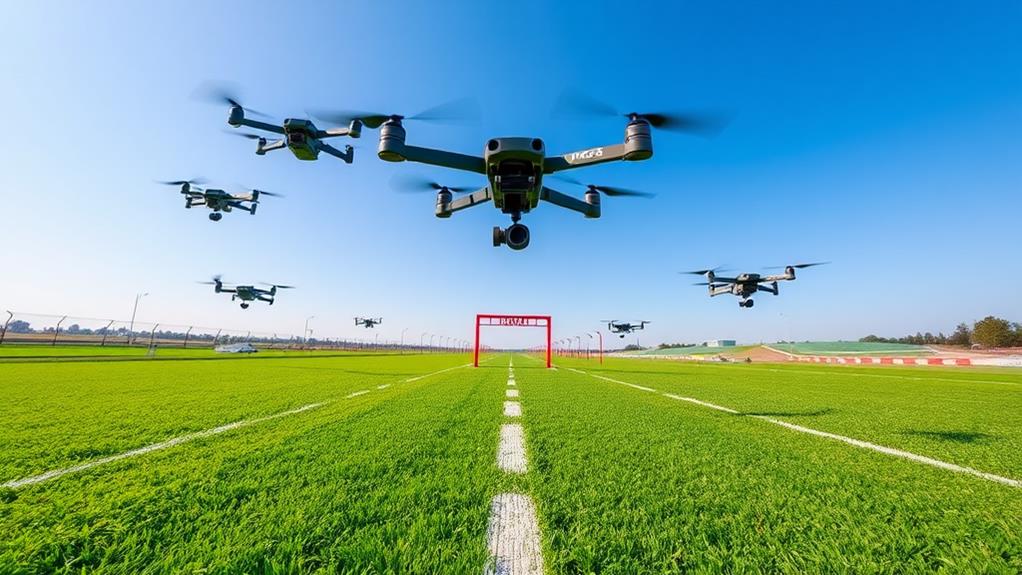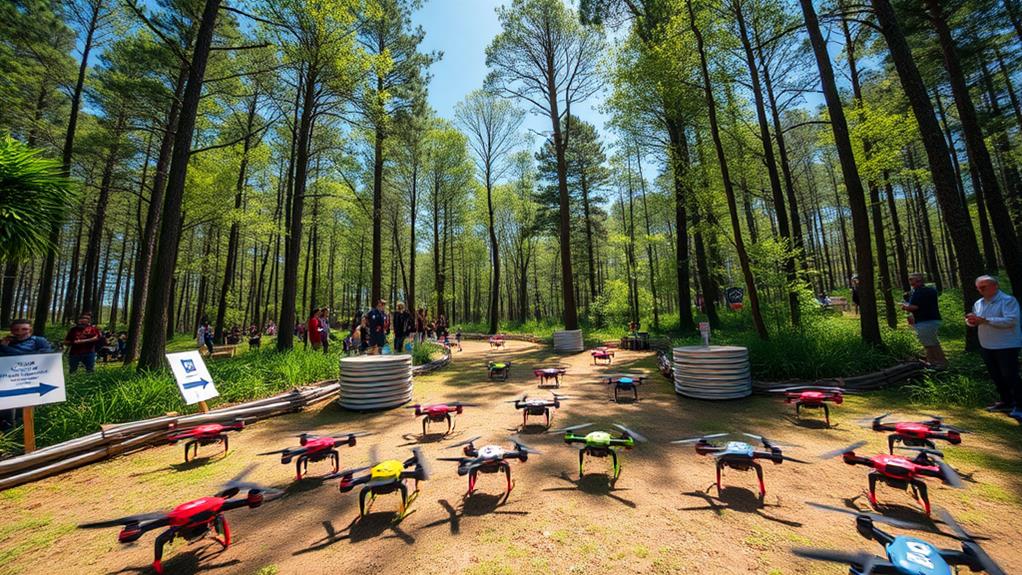To race drones safely, start by understanding local regulations, including FAA rules and no-fly zones, to avoid legal issues. Next, conduct thorough pre-race equipment checks to guarantee all components, from batteries to propellers, are in prime condition to prevent crashes. Practicing situational awareness helps you stay alert to other pilots and obstacles during races. Establish clear communication with fellow racers to share positions and movements, which reduces collision risks. Finally, engage in regular training to build muscle memory and master essential racing techniques. Each strategy is crucial for a safe racing experience, so keep exploring for more insights.
Understand Local Regulations

When racing drones, how well do you know the local regulations? Understanding the rules is essential for safe racing practices. Start by familiarizing yourself with the Federal Aviation Administration (FAA) regulations, which outline altitude limits and no-fly zones. These guidelines help you avoid potential hazards while flying FPV.
Next, check local laws that may require drone registration and adherence to specific guidelines for both recreational and competitive flying. Knowing these requirements guarantees you're compliant and can enjoy racing without legal issues.
Pay attention to community-specific restrictions, such as designated flying areas. By racing in approved locations, you minimize risks to people and property.
It's also important to stay updated on evolving regulations, as they can impact race formats and the legality of flying drones in particular zones. Engaging with local drone racing leagues is a great way to learn about compliance with regulations while fostering a culture of safety within the community.
Conduct Pre-Race Equipment Checks
Before hitting the race course, it's important to conduct thorough pre-race equipment checks. These checks guarantee all components of your racing drone, like motors, propellers, and batteries, are functioning properly. This minimizes the risk of mechanical failure during the race.
As a pilot, you need to verify that your drone is securely assembled; loose parts can lead to crashes or loss of control while traversing the course.
Next, inspect your FPV goggles. Clear video transmission and a proper fit are significant, as visual feedback is key for safe and effective piloting in FPV racing. Poorly functioning goggles could hinder your ability to react quickly to obstacles.
Don't overlook your remote controller. Check for low battery levels and confirm it responds well to your commands. Communication issues could compromise safety during a race, so it's imperative to address any problems beforehand.
Lastly, regular maintenance and thorough pre-race checks help identify wear and tear on spare parts. Replacing components before they become a hazard on race day can save you from potential disasters.
Prioritize these checks to enhance your racing experience and guarantee safety on the course.
Practice Situational Awareness

Practicing situational awareness is essential for safe drone racing, as it keeps you alert to your surroundings, including fellow pilots, obstacles, and spectators.
To excel in professional drone racing, you need to consistently scan your environment while you fly. This involves maintaining a mental map of the racecourse and potential hazards, enhancing both safety and performance.
Improving your spatial awareness can be achieved by utilizing visual markers on the course. These markers help you navigate effectively, ensuring you're aware of where other drone pilots are positioned.
To develop your situational awareness, start by practicing in controlled environments. Gradually introduce more complex courses to challenge your skills while honing your ability to identify and respond to obstacles.
Engaging with fellow pilots before and during races fosters better communication. When you're aware of each other's positions, you can coordinate your movements more effectively, minimizing risks of collisions.
Establish Clear Communication
Maintaining situational awareness is important, but clear communication among pilots takes safety to the next level. In the fast-paced world of drone racing, effective communication helps reduce collision risks and guarantees every racer knows their position and intentions.
Establishing a designated frequency for communication minimizes interference, allowing for seamless interactions among multiple pilots.
Pre-race briefings should cover safety protocols and communication strategies, preparing everyone for the event. During these briefings, drone racers can discuss standardized hand signals or radio communication methods to convey important information quickly. This practice enhances teamwork and fosters a culture of open communication, essential for creating a safer racing environment.
Encouraging racers to share their positions and movements during flights can greatly reduce the chances of accidents. By prioritizing clear communication, you make it easier for everyone to remain aware of their surroundings while flying.
Ultimately, establishing effective communication channels not only improves individual safety but also promotes mutual respect among racers. So, whether you're a seasoned pro or a newcomer, remember that clear communication is your ally in the thrilling world of drone racing.
Engage in Regular Training

Engaging in regular training is essential for any drone racer aiming to enhance their skills and guarantee safety on the track. To truly improve your skills, it's vital to practice consistently. Start by learning the basics, and then focus on developing muscle memory through repetitive maneuvers.
Create specific training goals to help you concentrate on mastering important techniques necessary for FPV racing. Incorporate diverse training exercises, such as traversing obstacle courses and simulating different weather conditions. This variety equips you with valuable insights that prepare you for real race environments, ensuring a safe experience.
Consistent practice sessions should mimic actual race conditions, allowing you to develop good habits and enhance your response times. Don't forget to include warm-up routines before flying; these can greatly reduce the likelihood of crashes by preparing both your mind and body for the demands of drone racing.
Ultimately, the more you train, the more confident you'll become in your abilities, leading to improved safety and performance on the track. Remember, regular training isn't just about flying; it's about becoming a safer, more skilled pilot.
Conclusion
To summarize, mastering safe drone racing isn't just about speed—it's a meticulous dance of precision, awareness, and communication. By understanding local regulations, conducting thorough equipment checks, and honing your situational awareness, you'll elevate your racing experience to extraordinary heights. Imagine zooming through the air like a superhero, all while ensuring safety and compliance. Regular training will sharpen your skills, making you not just a racer, but a true champion of the skies. So gear up and race wisely!

Leave a Reply